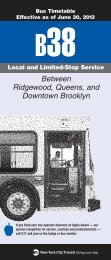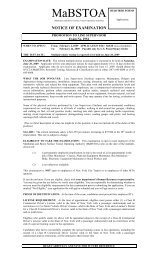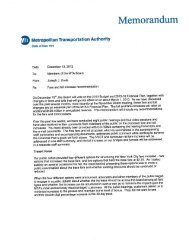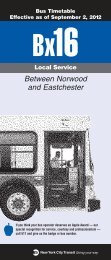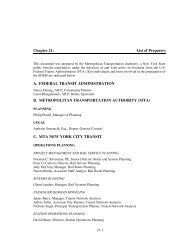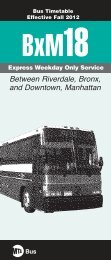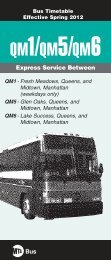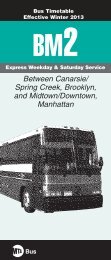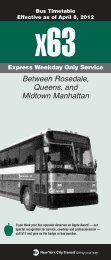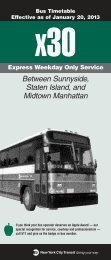Greening Mass Transit & Metro Regions: The Final Report - MTA
Greening Mass Transit & Metro Regions: The Final Report - MTA
Greening Mass Transit & Metro Regions: The Final Report - MTA
You also want an ePaper? Increase the reach of your titles
YUMPU automatically turns print PDFs into web optimized ePapers that Google loves.
TOD Case Study: NJ <strong>Transit</strong> Village Initiative<br />
<strong>The</strong> <strong>Transit</strong> Village Initiative (TVI) is a program sponsored by New Jersey<br />
<strong>Transit</strong> and the New Jersey Department of Transportation (NJDOT). It uses a<br />
smart-growth approach to redeveloping and revitalizing communities near<br />
transit facilities and making them more appealing places for people to live,<br />
work, and play, thereby reducing auto dependence and congestion and<br />
improving air quality. Under the TVI, municipalities must apply to a <strong>Transit</strong><br />
Village Task Force for <strong>Transit</strong> Village designation. Municipalities selected for<br />
<strong>Transit</strong> Village designation are those that have demonstrated a commitment<br />
to revitalizing and redeveloping the area around their transit facilities as a<br />
mixed-use neighborhood with a strong residential component. Much of the<br />
planning takes place prior to application. <strong>The</strong> <strong>Transit</strong> Village Task Force is<br />
comprised of 11 statewide agencies, including NJ <strong>Transit</strong> and NJDOT.<br />
Selections are made by the Task Force based upon a specific set of criteria,<br />
which includes:<br />
• A commitment for growth in jobs, housing, and transportation<br />
• A transit facility rail or light rail station, ferry terminal, a bus hub<br />
or bus transfer station<br />
• Vacant land and/or underutilized or deteriorated buildings within<br />
walking distance of transit where redevelopment can take place<br />
• An adopted land-use strategy (a redevelopment plan or zoning<br />
ordinance) for achieving compact, transit-supportive, mixed-use<br />
development within walking distance of transit<br />
• A strong residential component<br />
Ready-to-go projects:<br />
• Pedestrian and bicycle friendliness<br />
• <strong>Transit</strong> station as the focal point of the community, which can use<br />
its station plaza as a gathering place for community activities such as<br />
festivals, concerts, public ceremonies, and farmers’ markets<br />
• Station area is in a station area management plan, in a special<br />
improvement district (SID), or part of a Main Street New Jersey<br />
designation<br />
• Maximizing the appeal of transit through special features such as<br />
concierge service<br />
• Commuter parking for residents and non-residents<br />
• Support local arts and culture<br />
• Support the historic and architectural integrity of the community<br />
• Incorporate affordable housing<br />
<strong>The</strong> benefits of <strong>Transit</strong> Village designation include a commitment from the<br />
State of New Jersey to the municipality’s vision, coordination among the<br />
various state agencies that comprise the Task Force, priority funding from<br />
some state agencies, technical assistance, and eligibility for grants from<br />
NJDOT’s $1 million annual funding. Additional TOD Case Studies are located<br />
in the Appendix of this report.<br />
ACHIEVEMENTS TO DATE<br />
<strong>The</strong> <strong>MTA</strong> has a long history of investing in mixed-use development<br />
around transit stations – the most famous example being Grand<br />
Central Terminal, where the railroad created the swath of prime<br />
real estate along Park Avenue by leveraging the air rights over<br />
the terminal’s rail infrastructure – a model that the <strong>MTA</strong><br />
can continue to replicate today.<br />
A more contemporary example is the “Be in Beacon” project,<br />
a smart-growth partnership between <strong>Metro</strong>-North Railroad and<br />
the City of Beacon on the Hudson Line. <strong>The</strong> project arose out of<br />
collaboration between <strong>Metro</strong>-North, New York State, Beacon and<br />
20 other stakeholders, facilitated by the railroad. With its riverside<br />
setting and a burgeoning arts community, this waterfront town<br />
is undergoing a renaissance in which <strong>Metro</strong>-North is playing a<br />
key role. In October 2007, <strong>Metro</strong>-North issued a Request for<br />
Expressions of Interest (RFEI) relating to the “Be in Beacon” TOD<br />
projects, along with eco-friendly housing, riverfront development,<br />
and more. Other TOD projects in various stages of development<br />
by <strong>Metro</strong>-North or other partners include Harrison, Harriman,<br />
the Town of Amenia, Poughkeepsie, Mount Vernon, and several<br />
opportunities in the Bronx and suburban counties.<br />
<strong>The</strong> Long Island Rail Road has also extended its involvement in<br />
local smart-growth initiatives. Using a $25 million Federal <strong>Transit</strong><br />
Administration grant, the LIRR approached several townships with<br />
plans for intermodal projects. <strong>The</strong> result was a revitalization plan<br />
for Mineola centered on a new intermodal transit facility on the<br />
LIRR right-of-way – a short walk from the LIRR train station.<br />
Designed, scaled, and sited to enhance the downtown area, the<br />
facility earned several local smart-growth awards. <strong>The</strong> project<br />
also included plans for local business development, helping to<br />
concentrate growth around the LIRR station. In other projects,<br />
<strong>MTA</strong> and LIRR are working with officials from the Town of<br />
Brookhaven on a mixed-use, pedestrian-friendly commuting hub<br />
at the Ronkonkoma station. In addition, the <strong>MTA</strong> is partnering<br />
with the New York State Housing Finance Agency to identify<br />
TOD projects throughout Long Island, all aimed at concentrating<br />
future growth near rail and/or transit hubs.<br />
Other Current Initiatives at the <strong>MTA</strong><br />
At the instigation of the <strong>MTA</strong> and the Commission, the <strong>MTA</strong><br />
and Governor Paterson’s Smart Growth Cabinet have established<br />
a partnership and package of incentives to support TOD development.<br />
For additional Smart Growth/TOD information, see<br />
Appendices. Additionally, the <strong>MTA</strong> has established a single point<br />
of contact on its website www.mta.info/environment for communities<br />
in the <strong>MTA</strong> service area that express interest in Smart<br />
Growth/TOD projects.<br />
41



